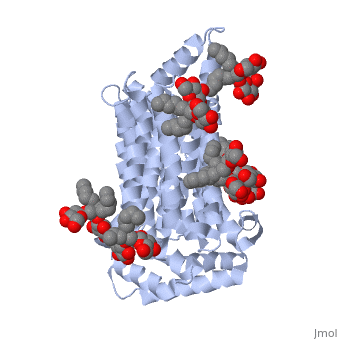Sanbox glut3
From Proteopedia
(Difference between revisions)
| Line 11: | Line 11: | ||
Alzheimer’s disease, shows levels of impaired glucose uptake and metabolism, which leads to the downgrade of many other factors in the brain. GLUT3 is responsible for transporting glucose from extracellular space to neuronal tissue (i.e. dendrites and axons). Decreased levels of GLUT3 in Alzheimer brain shows a positive correlation to decreased levels of N-acetylglucosamine. The impaired presence of GLUT3 leads to hyperphosphorylation of the Tau protein, which normally stabilizes neuronal microtubules. Lastly there is a reduction in the transcription for factor hypoxia-inducible factor 1, which plays a role in glucose metabolism in the brain. The comparison between a normal healthy brain and an Alzheimer brain relieved that there was a 25-30% decrease in GLUT3 levels in the Alzheimer brain. | Alzheimer’s disease, shows levels of impaired glucose uptake and metabolism, which leads to the downgrade of many other factors in the brain. GLUT3 is responsible for transporting glucose from extracellular space to neuronal tissue (i.e. dendrites and axons). Decreased levels of GLUT3 in Alzheimer brain shows a positive correlation to decreased levels of N-acetylglucosamine. The impaired presence of GLUT3 leads to hyperphosphorylation of the Tau protein, which normally stabilizes neuronal microtubules. Lastly there is a reduction in the transcription for factor hypoxia-inducible factor 1, which plays a role in glucose metabolism in the brain. The comparison between a normal healthy brain and an Alzheimer brain relieved that there was a 25-30% decrease in GLUT3 levels in the Alzheimer brain. | ||
| - | == | + | ==Mechanism == |
| - | Multiple mechanistic theories have been proposed for facilitated glucose transporters. The simple carrier model was the earliest theory proposed by Widdas and contains four steps. First, the empty carrier opens to the cis side of the membrane for glucose to | + | Multiple mechanistic theories have been proposed for facilitated glucose transporters. The simple carrier model was the earliest theory proposed by Widdas and contains four steps. First, the empty carrier opens to the cis side of the membrane for glucose to bind<ref name="three"/>. Then the substrate binding carrier translocates to the trans side of the membrane where it then releases glucose on that side. Last the empty carrier switches to the cis side. Multiple mechanistic theories, including the simple carrier model were proposed but all attempted to explain two key components of GLUT transporters, the asymmetry of the transport affinities and the trans-acceleration that occurs in the presence of hexose on the trans side*12. After considerable research, two popular models remain for class 1 glut transporters. The two-site/fixed site transporter theory explains the asymmetry by having both substrate binding sites simultaneously available*13. After glucose is bound, hexoses exchange between sites and speed the binding process. Although this method explains the asymmetry and the kinetics of class 1 glut transporters it is not known if all class 1 glut transporters undergo a trans-acceleration model*13. The alternating access model explains the mechanism for class 1 glut transporters that are symmetrical and follows three steps*14. The transporter has a cavity for small substrates, and contains a substrate binding site. The transporter also has two different configurational openings to one cell membrane or the other. This mechanism differs from the two-site/fixed site transporter theory by assuming there is only one binding site available at a time, leading to four different conformation states. An empty outward open state, an occluded transporter state, a inward open state and finally another occluded state*15. Trans-acceleration is only observed in a minority of class 1 glut transporters*16. GLUT3 has been proven to be dependent on trans-acceleration. This method was discovered when hexose was found to be moving against its concentration gradient*3. This movement is argued to support both the two-site transporter theory and the alternating access model. Geminate exchange, named by Naftalin et al, explains this movement with the idea that hexose could exchange freely between two binding sites within the carrier*12. While other scientist argue that hexose could move from outward to inward without glucose binding*17. |
| - | The two-site/fixed site transporter theory explains the asymmetry by having both substrate binding sites simultaneously | + | |
| - | The alternating access model follows three | + | |
| - | Trans-acceleration is only observed in a minority of class 1 glut | + | |
</StructureSection> | </StructureSection> | ||
Revision as of 04:11, 17 November 2015
Facilitated Glucose Transporter 3, Solute Carrier Family 2 (GLUT3/ SLC2A3) in Homo Sapiens
| |||||||||||
References
- ↑ 1.0 1.1 1.2 Long, W., & Cheeseman, C. I. (2015). Structure of, and functional insight into the GLUT family of membrane transporters. Cell Health and Cytoskeleton, 7, 167-183. doi:10.2147/CHC.S60484

